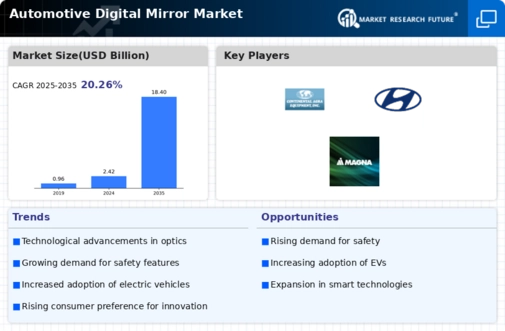Market Growth Projections
The Global Automotive Digital Mirror Market Industry is poised for substantial growth, with projections indicating a rise from 2.42 USD Billion in 2024 to an impressive 18.4 USD Billion by 2035. This growth trajectory suggests a compound annual growth rate of 20.25% from 2025 to 2035, reflecting increasing consumer acceptance and technological advancements. The market is likely to benefit from the integration of digital mirrors in various vehicle segments, including passenger cars and commercial vehicles. As manufacturers continue to innovate and enhance the functionality of digital mirrors, the industry is expected to evolve, offering new opportunities for growth and development.
Technological Advancements
The Global Automotive Digital Mirror Market Industry is witnessing rapid technological advancements that enhance vehicle safety and driver convenience. Innovations such as high-definition displays, integrated sensors, and artificial intelligence are transforming traditional mirrors into multifunctional devices. These advancements not only improve visibility but also provide features like blind-spot detection and lane departure warnings. As a result, the market is projected to reach 2.42 USD Billion in 2024, reflecting a growing demand for smart automotive solutions. The integration of these technologies is likely to drive consumer preference towards vehicles equipped with digital mirrors, thereby expanding the market further.
Growing Electric Vehicle Adoption
The surge in electric vehicle (EV) adoption is significantly influencing the Global Automotive Digital Mirror Market Industry. EV manufacturers are increasingly incorporating advanced technologies, including digital mirrors, to enhance vehicle aerodynamics and efficiency. Digital mirrors reduce drag compared to traditional mirrors, contributing to improved range and performance of electric vehicles. As the global EV market expands, with projections indicating a compound annual growth rate of 20.25% from 2025 to 2035, the demand for digital mirrors is likely to rise in tandem. This trend suggests a synergistic relationship between the growth of electric vehicles and the digital mirror market.
Government Regulations and Standards
Government regulations aimed at improving vehicle safety and reducing accidents are playing a crucial role in shaping the Global Automotive Digital Mirror Market Industry. Many countries are implementing stricter safety standards that encourage the adoption of advanced technologies, including digital mirrors. For example, regulations mandating the use of rearview cameras in new vehicles are driving manufacturers to integrate digital mirror systems. This regulatory push is expected to create a favorable environment for market growth, as compliance with these standards may lead to increased sales and market penetration for digital mirror technologies.
Market Expansion in Emerging Economies
Emerging economies are becoming increasingly important in the Global Automotive Digital Mirror Market Industry. As disposable incomes rise and urbanization accelerates, there is a growing demand for advanced automotive technologies in these regions. Countries in Asia-Pacific and Latin America are witnessing a surge in vehicle sales, leading to increased interest in digital mirror systems. Manufacturers are likely to focus on these markets to capitalize on the expanding consumer base. This trend may result in a significant increase in market share for digital mirrors, as consumers in these regions seek vehicles equipped with the latest safety and convenience features.
Rising Consumer Demand for Safety Features
Consumer preferences are increasingly shifting towards vehicles that prioritize safety, significantly impacting the Global Automotive Digital Mirror Market Industry. Digital mirrors offer enhanced visibility and safety features that traditional mirrors cannot provide. For instance, features like rearview cameras and adaptive lighting systems are becoming standard in modern vehicles. This trend is expected to contribute to the market's growth, with projections indicating a rise to 18.4 USD Billion by 2035. As safety regulations become more stringent globally, manufacturers are likely to adopt digital mirror technology to comply with these standards, further propelling market expansion.














